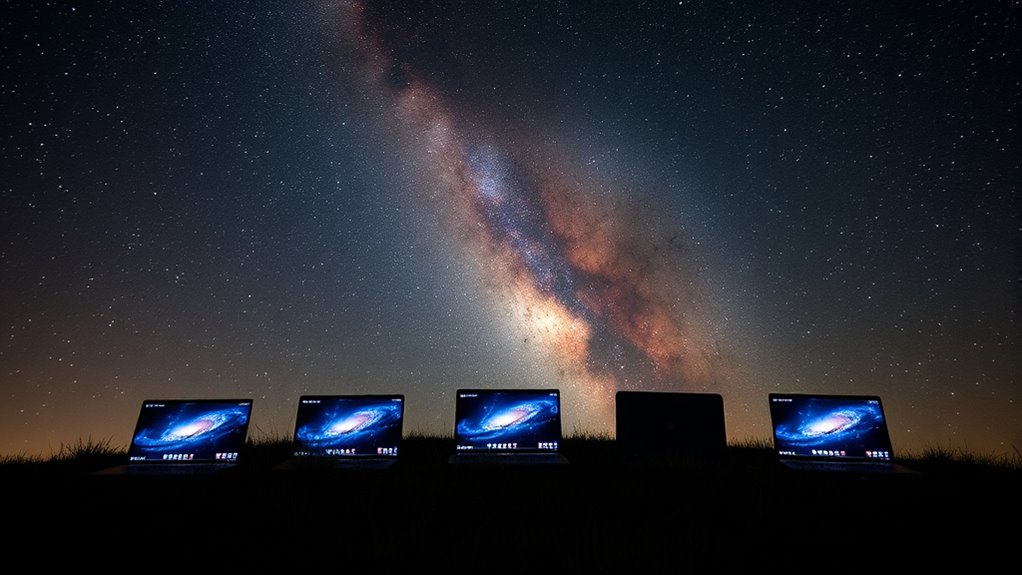If you’re looking for the best astronomy laptops with exceptional battery life, I’ve found five great options. The NIMO 15.6 IPS FHD Laptop offers a powerful 1TB SSD. The ACEMAGIC models stand out with their larger displays and impressive battery capacity. There’s also a solid choice with a 15.6-inch screen and lightweight design. Each one balances performance and portability perfectly for your stargazing needs. Stick around to explore the features that make these laptops ideal for you!
Key Takeaways
- The NIMO 15.6 IPS FHD Laptop offers exceptional build quality, a 1TB SSD, and efficient performance for stargazing needs.
- ACEMAGIC models feature large 17.3-inch displays and 6000mAh batteries, providing around five hours of outdoor use.
- All laptops include IPS panels for vibrant visuals, crucial for viewing star maps and celestial imagery accurately.
- Lightweight designs (3 to 3.8 lbs) enhance portability, making these laptops ideal for spontaneous astronomy sessions outdoors.
- Multiple connectivity options support integration with external devices, enhancing the stargazing experience and data access.
NIMO 15.6 IPS FHD Laptop with 16GB RAM and 1TB SSD
If you’re looking for a laptop that excels in both performance and portability, the NIMO 15.6 IPS FHD Laptop with 16GB RAM and 1TB SSD could be your ideal choice for stargazing. Weighing just 3.8 pounds, it’s easy to carry while exploring the night sky. The 15.6-inch anti-glare display offers vibrant visuals, perfect for tracking celestial events. With an Intel Alder Lake-N100 processor, I’ve found it handles multitasking smoothly. Plus, the backlit keyboard and fingerprint sensor add convenience. It’s not just reliable but also budget-friendly, making it a solid companion for anyone who loves to gaze at the stars.
Best For: The NIMO 15.6 IPS FHD Laptop is best for students, professionals, and casual users seeking a budget-friendly laptop with solid performance and portability.
Pros:
- Lightweight design makes it easy to carry, ideal for on-the-go use.
- High-resolution anti-glare display provides vibrant visuals for multimedia and productivity tasks.
- Strong performance with 16GB RAM and a 1TB SSD, allowing for efficient multitasking and quick data access.
Cons:
- Battery life may be limited to 3-4 hours under typical use, which may not suffice for extended sessions away from power sources.
- Integrated graphics may not support demanding tasks like gaming or intensive graphic design.
- Absence of an optical drive may be a drawback for users needing to read/write CDs or DVDs.
ACEMAGIC 2025 Laptop with 17.3-Inch FHD Display
For those who love stargazing but also need a reliable laptop for everyday tasks, the ACEMAGIC 2025 Laptop with its 17.3-inch FHD display is an excellent choice. Weighing just 3.52 pounds, it’s lightweight and portable, making it easy to take on your stargazing adventures. The vibrant screen enhances your viewing experience, whether you’re streaming or working. With a powerful 12th Gen Intel processor, 16GB RAM, and a 512GB SSD, multitasking is seamless. Plus, the 6000mAh battery supports up to 5 hours of use, allowing you to explore the universe without constant recharging. It’s a solid option for any astronomy enthusiast!
Best For: Astronomy enthusiasts and everyday users seeking a portable laptop with a vibrant display and solid performance for multitasking.
Pros:
- Lightweight and portable design, weighing only 3.52 pounds.
- High-performance 12th Gen Intel processor with 16GB RAM for seamless multitasking.
- Vibrant 17.3-inch FHD display enhances media viewing experiences.
Cons:
- Battery life is limited to up to 5 hours, which may require frequent charging during extended use.
- Integrated graphics may not support high-end gaming or graphics-intensive applications.
- No dedicated graphics card for users requiring advanced graphical performance.
ACEMAGIC 17.3 Laptop with Quad Core-12th Alder Lake N97 Processor
The ACEMAGIC 17.3 Laptop, powered by the 12th generation Alder Lake N97 processor, is an excellent choice for anyone who needs a reliable device while stargazing. With its 16GB DDR4 RAM and 512GB SSD, multitasking is a breeze. The 17.3-inch IPS FHD display provides an immersive viewing experience, perfect for analyzing star maps. Plus, the 6000mAh battery lasts about five hours, so I can enjoy my time outdoors without worrying about charging. Its lightweight design and durable metal casing make it easy to carry. With solid connectivity options, it keeps me connected while exploring the night sky.
Best For: Those seeking a portable and powerful laptop for outdoor activities like stargazing or multitasking on the go.
Pros:
- High Performance: Equipped with a 12th generation Alder Lake N97 processor and 16GB DDR4 RAM for smooth multitasking.
- Immersive Display: The 17.3-inch IPS FHD display offers a wide viewing area, ideal for analyzing star maps and enjoying multimedia.
- Long Battery Life: The 6000mAh battery provides approximately five hours of usage, perfect for outdoor adventures without frequent recharging.
Cons:
- Limited Battery Life: While five hours is decent, it may not be enough for extended outdoor use without access to power.
- Weight: Despite being lightweight, the 17.3-inch size may still feel bulky for some users needing ultra-portability.
- No Dedicated GPU: Lacks a dedicated graphics card, which may limit performance in graphics-intensive applications or gaming.
15.6″ Laptop Computer with 16GB RAM and 512GB SSD
Looking for a lightweight yet powerful laptop perfect for stargazing and beyond? The 15.6” Laptop Computer with 16GB RAM and 512GB SSD is an excellent choice. Its Full HD IPS display minimizes eye strain, making it ideal for late-night sky observations. Weighing just 3.54 pounds, it’s easy to carry around. Plus, the Intel N5095 processor ensures smooth multitasking. With a battery life of around 5 hours, you can enjoy streaming or light gaming without worrying about recharging. Customer feedback highlights its reliability, making it a solid investment for students and professionals alike. You won’t be disappointed!
Best For: Students and professionals seeking a portable laptop for multitasking, multimedia use, and light gaming.
Pros:
- Lightweight design (3.54 pounds) enhances portability for on-the-go use.
- Full HD IPS display reduces eye strain, perfect for extended viewing sessions.
- Robust performance with 16GB RAM and 512GB SSD allows for smooth multitasking and handling demanding projects.
Cons:
- Battery life of approximately 5 hours may require frequent recharging during heavy use.
- Integrated graphics may not support high-end gaming or intensive graphic design tasks.
- Limited upgrade options due to the laptop’s design and components.
Laptop Computer, 15.6 FHD IPS Student Laptop
Students and travelers who appreciate portability and style will find the 15.6 FHD IPS Student Laptop an excellent choice for their needs. Weighing just around 3 pounds, it’s lightweight and features a stunning 15.6-inch FHD display, perfect for stargazing apps. With a powerful Jasper Lake N5095 processor, 12GB RAM, and 512GB SSD, multitasking is smooth and efficient. The battery lasts up to 6 hours, which is great for long nights under the stars. Plus, its various ports and Bluetooth connectivity let me connect to all my devices easily. Overall, it’s a solid companion for both studies and stargazing adventures.
Best For: Students and travelers seeking a lightweight, portable laptop with strong performance for multitasking and multimedia use.
Pros:
- Lightweight and portable design makes it easy to carry around for classes or travel.
- Powerful performance with a Jasper Lake N5095 processor and 12GB RAM, ideal for multitasking and light gaming.
- Vivid FHD IPS display enhances visuals and reduces eye strain, perfect for long study sessions.
Cons:
- Battery life may vary, with some users reporting significantly shorter durations than advertised.
- Potential hardware quality concerns as noted by some users experiencing slowdowns.
- Customer service experiences vary, leading to mixed reviews regarding support and assistance.
Factors to Consider When Choosing Astronomy Laptops With High Battery Life

When I’m picking an astronomy laptop, I always consider battery capacity and how long it lasts during stargazing sessions. It’s also vital to look at processor efficiency and display quality, since I need a clear view of the night sky. Plus, portability and connectivity options can make a big difference when I’m out and about.
Battery Capacity and Longevity
Battery capacity and longevity are essential factors to take into account if you’re choosing a laptop for stargazing. A higher battery capacity, measured in milliampere-hours (mAh) or watt-hours (Wh), usually means you can enjoy longer observation sessions without needing to recharge. Laptops with larger batteries are particularly beneficial during those late-night skywatching adventures. Additionally, power-efficient processors and integrated graphics can help maximize battery life by cutting down on energy consumption. Features like low-power display settings and adaptive brightness also play a role in enhancing battery longevity. However, keep in mind that real-world battery life can vary based on how intensely you’re using the laptop, screen brightness, and any peripherals connected during your observations.
Processor Performance and Efficiency
While selecting a laptop for stargazing, it’s crucial to take into account processor performance and efficiency, as they directly impact how long you can use your device on a single charge. A high-performance processor, like those from the 12th Gen Intel Alder Lake series, ensures efficient multitasking and faster data processing, which conserves battery life during intensive tasks. Look for energy-efficient architectures, such as 7nm lithography, that reduce power consumption while maintaining speed. Additionally, processors with lower thermal output, around 12W TDP, help prevent overheating and allow extended use without throttling. Ultimately, choosing modern processors with power-saving modes can greatly enhance battery longevity, making your stargazing experience uninterrupted and enjoyable.
Display Quality and Size
Choosing the right display quality and size for your astronomy laptop is essential for a satisfying stargazing experience. I’ve found that a larger screen, like 15.6 inches or more, greatly enhances visibility for star charts and intricate astronomical images during long observation sessions. Opting for a high-resolution screen, especially Full HD (1920×1080) or better, gives you clearer, more accurate visualizations of celestial objects, which boosts your observational accuracy. I also recommend an IPS panel for consistent color accuracy and wide viewing angles, perfect for examining detailed data from various positions. Ultimately, a display with an anti-glare finish reduces reflections and eye strain, ensuring a more comfortable experience while you explore the night sky.
Portability and Weight
When you’re out under the stars, portability and weight play a fundamental role in your astronomy laptop selection. I always look for laptops that weigh under 4 pounds, making them easy to carry while I’m trekking to my observation spot. A compact design and slim profile are essential; they fit snugly in my backpack or camera bag without adding extra bulk. Having a laptop with a battery life of 6 hours or more is crucial, too, as it allows me to enjoy uninterrupted sessions in remote locations without worrying about finding a power outlet. Plus, lightweight yet durable materials ensure my gear can withstand outdoor conditions while remaining easy to transport.
Connectivity Options and Features
Connectivity options and features are essential to contemplate for an astronomy laptop, especially since I often find myself in remote locations. I make sure my laptop supports dual-band Wi-Fi (2.4GHz and 5GHz) with standards like 802.11ac or Wi-Fi 6, ensuring fast and reliable connections. Multiple USB ports, especially USB 3.0 or Type-C, are necessary for connecting external drives and equipment critical for data collection. HDMI or DisplayPort outputs allow me to connect to monitors for presentations or real-time star mapping. I also check for Bluetooth 5.0, which enables seamless pairing with wireless accessories. Finally, a decent built-in webcam and microphone are important for video conferencing with fellow astronomy enthusiasts or collaborating on research.
Frequently Asked Questions
What Screen Resolution Is Best for Astronomy Tasks?
I find that a screen resolution of at least 1920×1080 pixels is best for astronomy tasks. This resolution gives me a clear and detailed view of celestial images and data, which is vital when I’m analyzing star charts or astrophotographs. Higher resolutions, like 4K, can be beneficial, but they often drain battery life faster. Ultimately, it’s about balancing clarity with performance, ensuring I enjoy stargazing without interruptions.
Can I Upgrade the RAM in These Laptops?
Yes, you can upgrade the RAM in most laptops, but it depends on the model. I always check the manufacturer’s specifications before buying. Some laptops have soldered RAM, meaning you can’t upgrade them at all. Others have accessible slots, allowing for a straightforward upgrade. If I’m planning to run demanding astronomy software, I make sure I have enough RAM for smooth performance. It’s a great way to enhance my laptop’s capabilities.
Are These Laptops Suitable for Astrophotography?
Sure, using a laptop for astrophotography is like trying to catch a shooting star in a jar! These laptops can be suitable for astrophotography, but it really depends on the specs. I’ve found that a powerful processor and good graphics card are essential for editing those stunning night sky images. If you’re serious about it, make sure to check the hardware before diving into your cosmic adventures. You won’t regret it!
How Do I Extend Battery Life While Stargazing?
To extend battery life while stargazing, I always dim my screen brightness and close unnecessary apps. I also switch to power-saving mode and turn off Bluetooth and Wi-Fi when I don’t need them. It helps to use a dark theme for apps, too. I’ll even keep my laptop cool, as heat can drain the battery faster. Ultimately, I bring a portable charger just in case I need that extra boost.
Do These Laptops Support External Monitor Connections?
Absolutely, these laptops do support external monitor connections! I remember when I first connected my laptop to a larger screen for stargazing. The increased display size made it so much easier to analyze star maps. If you’re looking to enhance your viewing experience, connecting an external monitor is a great idea. Just check for HDMI or DisplayPort availability, and you’re all set for a more immersive stargazing session!
Conclusion
In the vast cosmos of laptops, finding the right one for stargazing is like discovering a hidden constellation. Whether you prefer the sleek NIMO or the powerful ACEMAGIC, each offers stellar battery life to keep your explorations alive under the night sky. With these choices, you’ll have the perfect companion for your astronomical adventures, ensuring your curiosity shines bright. So, gear up, laptop in hand, and let the universe unfold its wonders before you!















